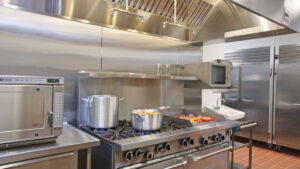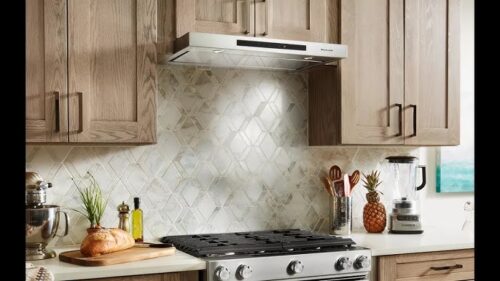If you cook with a gas stove, you’ve probably noticed how quickly it can heat up your kitchen—and not just with warmth. The flames release moisture, carbon monoxide, nitrogen dioxide, and tiny particles that can linger in the air long after you’re done cooking. So it’s no surprise many homeowners ask, “Do I need a range hood for a gas stove?”
The answer to that is yes for those that care about clean air, comfort, and your kitchen’s long-term health. While a gas stove can deliver that perfect sear or simmer, it also produces byproducts that need proper ventilation. A good range hood doesn’t just remove smoke and odors—it helps keep your indoor air safer and your kitchen surfaces cleaner.
Do i need a range hood for a gas stove?

While it’s technically possible to cook without one, installing a range hood is strongly recommended. Without proper ventilation, prolonged exposure to combustion byproducts can lead to respiratory irritation, headaches, and even long-term health risks. While it’s possible to cook without one, you’re leaving yourself exposed to harmful gases, particulates, and lingering odors.
Even if your kitchen has windows or an exhaust fan, a dedicated range hood is far more effective because it’s designed specifically to capture and remove airborne contaminants right at the source.
Beyond health and safety, range hoods also add practical benefits: they help reduce heat accumulation from prolonged cooking, which keeps your kitchen more comfortable, and many modern hoods also incorporate lighting to improve visibility while cooking. Over time, investing in a good range hood not only protects your health but also prolongs the life of your kitchen surfaces and appliances.
In short, a range hood is far more than a decorative kitchen accessory—it’s a functional necessity for anyone using a gas stove. It safeguards your health, maintains a cleaner environment, and ensures your cooking space remains comfortable and enjoyable.
Benefits of Having a Range Hood for a Gas Stove
Cooking with a gas stove is efficient and precise, but it comes with challenges like smoke, grease, strong odors, and harmful gases. A range hood is not just a kitchen accessory—it’s a tool that protects your health, preserves your kitchen, and improves your cooking experience. Here’s a breakdown of the benefits of having a range hood for a gas stove:
- Significantly Improves Air Quality – Gas stoves release byproducts like carbon monoxide, nitrogen dioxide, and fine particulate matter. These pollutants can irritate your lungs, eyes, and throat, and prolonged exposure may affect overall respiratory health. A range hood effectively removes these harmful gases from the kitchen, providing a safer environment for cooking and living.
- Efficient Smoke and Odor Removal – Cooking certain foods like onions, garlic, or fried dishes produces strong odors that linger in the home. A range hood quickly captures smoke, steam, and cooking smells, preventing them from spreading to other rooms and keeping your home fresh.
- Prevents Grease and Residue Buildup – When cooking on a gas stove, tiny droplets of grease can settle on walls, cabinets, and countertops, creating sticky surfaces that are hard to clean. A range hood traps this airborne grease, reducing cleaning time and protecting your kitchen’s surfaces from damage and discoloration.
- Regulates Kitchen Temperature – Long cooking sessions on a gas stove can heat up the kitchen, making it uncomfortable, especially in warmer climates. A range hood ventilates excess heat and steam, helping maintain a more comfortable cooking environment.
- Enhanced Cooking Visibility – Many range hoods come with integrated lights that illuminate the stovetop. This makes it easier to monitor food, measure ingredients, and cook safely, especially during evening hours or in kitchens with limited natural light.
- Protects Appliances and Surfaces – By minimizing smoke, moisture, and grease, a range hood indirectly prolongs the life of your kitchen appliances, countertops, cabinets, and paintwork, reducing maintenance costs and preserving your kitchen’s appearance.
- Adds Value and Aesthetic Appeal – A modern, well-installed range hood not only functions efficiently but also adds a professional and stylish look to your kitchen, increasing the overall home value and making it more appealing to potential buyers.
- Supports Healthier Cooking – By venting out pollutants and reducing lingering smoke, a range hood ensures that your cooking space promotes better respiratory health and minimizes exposure to irritants, especially important for families with children, elderly members, or those with allergies.
Installing a range hood for a gas stove goes far beyond aesthetics—it safeguards your health, enhances comfort, protects your kitchen, and ensures a cleaner, more efficient cooking experience. It’s a long-term investment that benefits both your home and your well-being.
Situations Where a Range Hood May Be Optional
While range hoods are highly recommended for gas stoves due to their ability to remove smoke, grease, odors, and harmful gases, there are certain situations where they may not be strictly necessary. Understanding these exceptions can help you make a more informed decision based on your kitchen setup, cooking habits, and ventilation options.
- Kitchens with Excellent Natural Ventilation – If your kitchen has large windows, sliding doors, or a well-planned cross-ventilation system, smoke and odors can escape naturally. In such setups, cooking fumes are quickly dispersed, reducing the immediate need for a range hood. However, it’s important to note that while natural ventilation helps with smoke and odors, it may not completely eliminate harmful gases like carbon monoxide or nitrogen dioxide, which are produced by gas stoves.
- Infrequent or Light Cooking – For households that rarely use their gas stove, or cook meals that produce minimal smoke, grease, or steam, the presence of a range hood may be optional. Light cooking, such as boiling water or reheating pre-cooked meals, generates fewer airborne pollutants, making natural or passive ventilation sufficient in many cases.
- Outdoor or Semi-Open Kitchens – In outdoor kitchens, patios, or semi-open cooking areas, the open-air environment naturally dissipates smoke, heat, and odors. Since there is constant airflow, a range hood may not be necessary, and any smoke or fumes quickly leave the cooking area without affecting indoor air quality.
- Alternative Ventilation Systems – Some homes may already have strong central exhaust systems, HVAC ventilation, or high-efficiency air purifiers capable of handling kitchen pollutants. In these scenarios, a dedicated range hood may be optional, as the existing system can manage smoke, steam, and harmful gases, though it might not capture them as close to the source as a hood would.
- Space or Budget Limitations – In smaller kitchens where space is constrained, or for homeowners on a limited budget, installing a range hood may be skipped. While this is possible, it comes with trade-offs: smoke, odors, and grease may accumulate faster, requiring more frequent cleaning and potentially impacting long-term kitchen maintenance.
Although range hoods provide significant health, comfort, and cleanliness benefits for gas stove users, there are scenarios where they may be optional. Well-ventilated kitchens, light cooking habits, outdoor setups, homes with effective alternative ventilation, or budget and space constraints may allow you to cook without a range hood.
However, it’s crucial to weigh these factors carefully, as even in these situations, a range hood provides a higher level of air quality, safety, and long-term kitchen protection that passive measures cannot fully replicate.
Key Considerations Before Installing a Range Hood

Installing a range hood for your gas stove is more than just picking a stylish appliance—it requires careful planning to ensure it works efficiently, protects your health, and fits your kitchen layout. Below are the key considerations to keep in mind:
- Type of Range Hood – Decide between a ducted (vented) hood that expels air outside or a ductless (recirculating) hood that filters and recirculates air. Ducted hoods are generally more effective at removing smoke, odors, and harmful gases, while ductless models are easier to install in kitchens without exterior venting options.
- Size and Coverage – The hood should be at least as wide as your stove, ideally a few inches larger on each side. Proper coverage ensures all smoke, steam, and grease are captured before spreading into your kitchen.
- Airflow Capacity (CFM) – The power of a range hood is measured in cubic feet per minute (CFM). Gas stoves typically require higher CFM than electric stoves. Consider the size of your stove, cooking habits, and kitchen layout to select a hood with adequate airflow.
- Installation Height – The optimal height for a range hood is usually 24–30 inches above the stove for most residential kitchens. Installing it too high reduces efficiency, while installing it too low can interfere with cooking and create a safety hazard.
- Noise Level – Range hoods vary in noise output. Check the decibel rating if you want a quieter kitchen, especially for open-concept layouts. Some hoods include multiple fan speeds to balance performance and noise.
- Maintenance and Filter Type – Consider how easy it is to clean and maintain the hood. Ductless models require regular filter replacement, while ducted hoods may need occasional duct cleaning. Stainless steel or aluminum filters are common and often dishwasher-safe.
- Design and Kitchen Aesthetics – While functionality is key, the range hood should also complement your kitchen style. Options include under-cabinet, wall-mounted, island, and chimney hoods. Choose a design that fits your space and enhances the overall look of your kitchen.
- Budget – Costs vary based on type, size, features, and brand. Factor in installation costs as well, especially for ducted hoods that require venting through walls or ceilings.
Choosing the right range hood requires balancing functionality, efficiency, and aesthetics. Considering factors like type, size, airflow, installation, noise, maintenance, and budget ensures that your hood effectively protects your kitchen, enhances your cooking experience, and lasts for years.
Alternatives to Range Hoods
While range hoods are the most effective way to remove smoke, grease, and harmful gases from your kitchen, there are situations where alternatives may be considered, either due to space, budget, or ventilation limitations. Here are some common alternatives:
- Exhaust Fans – A wall-mounted or ceiling exhaust fan can help ventilate smoke, steam, and odors. While less efficient than a range hood at capturing grease and gases at the source, it can improve air circulation and reduce lingering smells, especially when paired with open windows.
- Window Ventilation – Opening windows while cooking allows fresh air to flow in and push smoke and odors out. Cross-ventilation—opening windows on opposite sides of the kitchen—enhances airflow and can significantly reduce airborne pollutants, though it may not fully remove harmful gases.
- Air Purifiers with HEPA and Carbon Filters – High-quality air purifiers can capture particulate matter and some odors. Units with activated carbon filters can reduce cooking smells, and HEPA filters trap fine particles. However, air purifiers do not remove gases like carbon monoxide efficiently and are most effective as a supplementary solution.
- Downdraft Ventilation Systems – Some modern stovetops come with built-in downdraft vents that pull smoke and steam downwards and out through ducts. They are less visually intrusive than traditional hoods but may be less effective for high-heat cooking or larger gas stoves.
- Cook in Outdoor or Semi-Open Spaces – For homes with patios, balconies, or semi-open kitchens, cooking outdoors allows smoke and odors to dissipate naturally. This is the most natural alternative, though it isn’t always practical for daily use.
- Portable Ventilation Units – Small, movable fans or venting units can help direct smoke and steam toward windows or exhaust points. While convenient, they usually provide only partial relief and cannot fully replace a properly installed range hood.
While range hoods remain the most efficient way to protect your kitchen from smoke, grease, and harmful gases, alternatives like exhaust fans, open windows, air purifiers, downdraft systems, outdoor cooking, and portable units can provide varying levels of ventilation. These options are often supplementary or situational, so understanding their limitations is key to maintaining a safe and comfortable kitchen environment.
Maintenance Tips

A range hood is an essential appliance for keeping your kitchen clean and safe, but it only works effectively if properly maintained. Regular maintenance ensures your hood removes smoke, grease, and harmful gases efficiently while prolonging its lifespan. Below are key maintenance tips:
- Clean Grease Filters Regularly – Most range hoods have removable metal or mesh filters that trap grease. These should be cleaned every 1–3 months depending on usage. Wash them with warm, soapy water or in a dishwasher if they are dishwasher-safe.
- Replace Charcoal Filters (for Ductless Hoods) – Ductless or recirculating hoods use charcoal filters to remove odors. Unlike metal filters, these cannot be washed and need replacement every 3–6 months or according to the manufacturer’s instructions.
- Wipe Down Exterior Surfaces – Grease and grime can accumulate on the hood’s exterior. Regularly wipe it down with a damp cloth and mild detergent to maintain both hygiene and appearance. Avoid abrasive cleaners that can scratch the surface.
- Check and Clean the Ductwork (for Ducted Hoods) – Over time, grease and debris can build up in the vent duct. Inspect the duct at least once a year and clean it as needed to ensure proper airflow and prevent fire hazards.
- Inspect Fan Blades and Motor – Dust and grease can accumulate on the fan blades and motor, reducing efficiency. Turn off power to the unit and carefully clean the blades. Some models allow you to access the motor for light cleaning—refer to the manufacturer’s guidelines.
- Replace Lights When Needed – Many range hoods come with built-in lights to illuminate the cooking surface. Replace burnt-out bulbs promptly to maintain visibility and safe cooking conditions.
- Test Airflow Regularly – Ensure the hood is effectively pulling smoke and odors by checking airflow at different fan speeds. If you notice a significant drop in performance, it may indicate clogged filters or ductwork issues.
- Follow Manufacturer Guidelines – Always follow the specific maintenance instructions provided with your range hood. Different brands and models may have unique cleaning requirements or filter replacement schedules.
Regular maintenance is crucial for keeping your range hood functioning efficiently and safely. Cleaning filters, wiping surfaces, inspecting ducts and fans, and replacing lights ensures optimal performance, prolongs the appliance’s lifespan, and keeps your kitchen healthier and more comfortable.
Conclusion
Deciding on kitchen ventilation can feel overwhelming, especially with the many options available. Do I need a range hood for a gas stove? This question often comes up for homeowners weighing air quality, cooking habits, and space design. While some kitchens may manage without one, considering factors like smoke, odors, and heat can make a range hood a valuable addition to your cooking environment, helping maintain a cleaner, more comfortable kitchen over time.

